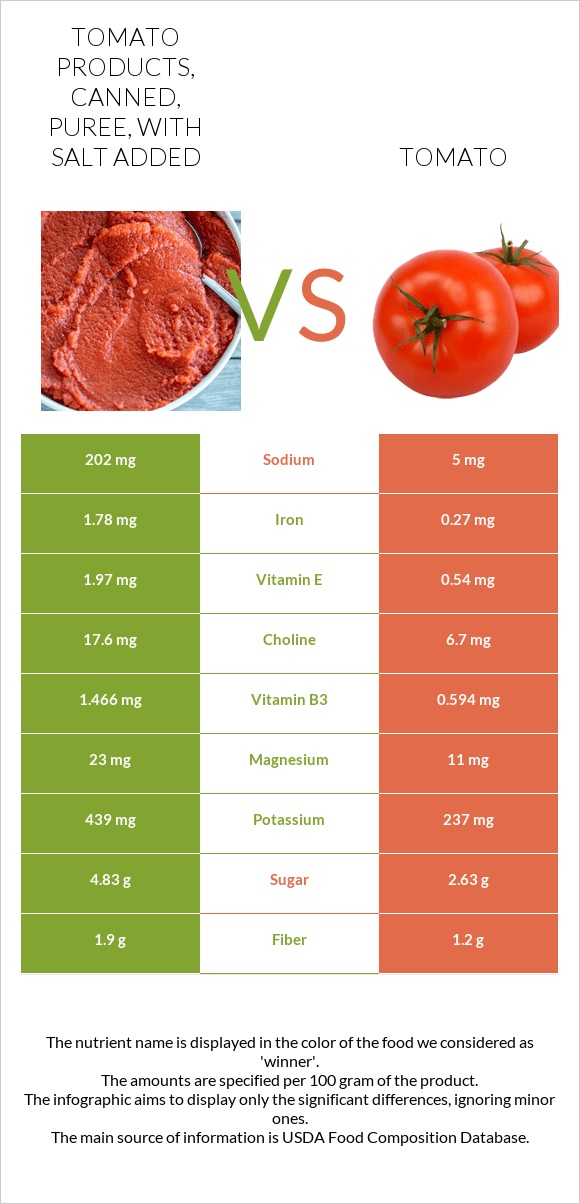Tomato products, canned, puree, with salt added vs. Tomato — In-Depth Nutrition Comparison
Compare
What are the differences between tomato products, canned, puree, with salt added and tomatoes?
- Tomato products, canned, puree, with salt added is higher in copper, iron, vitamin E, vitamin B5, potassium, and vitamin B3; however, tomatoes are richer in vitamin A.
- Tomato products, canned, puree, with salt added's daily need coverage for copper is 25% more.
- Tomatoes contain 40 times less sodium than tomato products, canned, puree, with salt added. Tomato products, canned, puree, with salt added contains 202mg of sodium, while tomatoes contain 5mg.
We used Tomato products, canned, puree, with salt added and Tomatoes, red, ripe, raw, year round average types in this article.
Infographic

Infographic link
Mineral Comparison
Mineral comparison score is based on the number of minerals by which one or the other food is richer. The "coverage" charts below show how much of the daily needs can be covered by 300 grams of the food.
| Contains more MagnesiumMagnesium | +109.1% |
| Contains more CalciumCalcium | +80% |
| Contains more PotassiumPotassium | +85.2% |
| Contains more IronIron | +559.3% |
| Contains more CopperCopper | +386.4% |
| Contains more ZincZinc | +111.8% |
| Contains more PhosphorusPhosphorus | +66.7% |
| Contains more ManganeseManganese | +48.2% |
| Contains more SeleniumSelenium | +∞% |
| Contains less SodiumSodium | -97.5% |
Vitamin Comparison
Vitamin comparison score is based on the number of vitamins by which one or the other food is richer. The "coverage" charts below show how much of the daily needs can be covered by 300 grams of the food.
| Contains more Vitamin EVitamin E | +264.8% |
| Contains more Vitamin B2Vitamin B2 | +321.1% |
| Contains more Vitamin B3Vitamin B3 | +146.8% |
| Contains more Vitamin B5Vitamin B5 | +394.4% |
| Contains more Vitamin B6Vitamin B6 | +57.5% |
| Contains more CholineCholine | +162.7% |
| Contains more Vitamin CVitamin C | +29.2% |
| Contains more Vitamin AVitamin A | +61.5% |
| Contains more Vitamin B1Vitamin B1 | +48% |
| Contains more Vitamin KVitamin K | +132.4% |
| Contains more FolateFolate | +36.4% |
All nutrients comparison - raw data values
| Nutrient |  |
 |
DV% diff. |
| Copper | 0.287mg | 0.059mg | 25% |
| Iron | 1.78mg | 0.27mg | 19% |
| Vitamin E | 1.97mg | 0.54mg | 10% |
| Sodium | 202mg | 5mg | 9% |
| Vitamin B5 | 0.44mg | 0.089mg | 7% |
| Potassium | 439mg | 237mg | 6% |
| Vitamin B2 | 0.08mg | 0.019mg | 5% |
| Vitamin B3 | 1.466mg | 0.594mg | 5% |
| Vitamin B6 | 0.126mg | 0.08mg | 4% |
| Vitamin K | 3.4µg | 7.9µg | 4% |
| Fiber | 1.9g | 1.2g | 3% |
| Vitamin C | 10.6mg | 13.7mg | 3% |
| Magnesium | 23mg | 11mg | 3% |
| Carbs | 8.98g | 3.89g | 2% |
| Zinc | 0.36mg | 0.17mg | 2% |
| Phosphorus | 40mg | 24mg | 2% |
| Vitamin A | 26µg | 42µg | 2% |
| Manganese | 0.169mg | 0.114mg | 2% |
| Choline | 17.6mg | 6.7mg | 2% |
| Protein | 1.65g | 0.88g | 2% |
| Folate | 11µg | 15µg | 1% |
| Calories | 38kcal | 18kcal | 1% |
| Vitamin B1 | 0.025mg | 0.037mg | 1% |
| Selenium | 0.7µg | 0µg | 1% |
| Fructose | 2.38g | 1.37g | 1% |
| Calcium | 18mg | 10mg | 1% |
| Fats | 0.21g | 0.2g | 0% |
| Net carbs | 7.08g | 2.69g | N/A |
| Sugar | 4.83g | 2.63g | N/A |
| Saturated fat | 0.029g | 0.028g | 0% |
| Monounsaturated fat | 0.031g | 0.031g | 0% |
| Polyunsaturated fat | 0.086g | 0.083g | 0% |
| Tryptophan | 0.011mg | 0.006mg | 0% |
| Threonine | 0.038mg | 0.027mg | 0% |
| Isoleucine | 0.032mg | 0.018mg | 0% |
| Leucine | 0.047mg | 0.025mg | 0% |
| Lysine | 0.049mg | 0.027mg | 0% |
| Methionine | 0.009mg | 0.006mg | 0% |
| Phenylalanine | 0.035mg | 0.027mg | 0% |
| Valine | 0.034mg | 0.018mg | 0% |
| Histidine | 0.026mg | 0.014mg | 0% |
Macronutrient Comparison
Macronutrient breakdown side-by-side comparison
Protein:
1.65 g
Fats:
0.21 g
Carbs:
8.98 g
Water:
87.88 g
Other:
1.28 g
Protein:
0.88 g
Fats:
0.2 g
Carbs:
3.89 g
Water:
94.52 g
Other:
0.51 g
| Contains more ProteinProtein | +87.5% |
| Contains more CarbsCarbs | +130.8% |
| Contains more OtherOther | +151% |
~equal in
Fats
~0.2g
~equal in
Water
~94.52g
Fat Type Comparison
Fat type breakdown side-by-side comparison
Saturated fat:
Sat. Fat
0.029 g
Monounsaturated fat:
Mono. Fat
0.031 g
Polyunsaturated fat:
Poly. Fat
0.086 g
Saturated fat:
Sat. Fat
0.028 g
Monounsaturated fat:
Mono. Fat
0.031 g
Polyunsaturated fat:
Poly. Fat
0.083 g
~equal in
Saturated fat
~0.028g
~equal in
Monounsaturated fat
~0.031g
~equal in
Polyunsaturated fat
~0.083g
Carbohydrate type comparison
Carbohydrate type breakdown side-by-side comparison
Starch:
0 g
Sucrose:
0 g
Glucose:
2.45 g
Fructose:
2.38 g
Lactose:
0 g
Maltose:
0 g
Galactose:
0 g
Starch:
0 g
Sucrose:
0 g
Glucose:
1.25 g
Fructose:
1.37 g
Lactose:
0 g
Maltose:
0 g
Galactose:
0 g
| Contains more GlucoseGlucose | +96% |
| Contains more FructoseFructose | +73.7% |
~equal in
Starch
~0g
~equal in
Sucrose
~0g
~equal in
Lactose
~0g
~equal in
Maltose
~0g
~equal in
Galactose
~0g